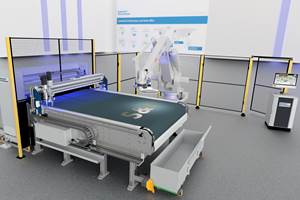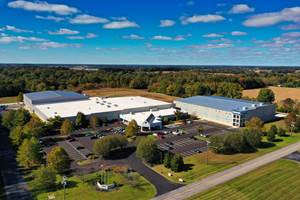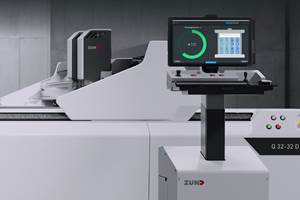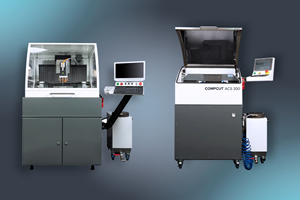Bringing lean manufacturing to cutting and kitting
AGFM/GFM is developing a cutting and kitting system designed to maximize operator efficiency at the cutting table, and to minimize ply layup sequencing errors during sorting.

AGFM/GFM has developed a cutting and kitting system designed to maximize operator time and minimize layup sequence errors.
American GFM Corp. (AGFM; Chesapeake, Virginia) and GFM GmbH (GFM, Steyr, Austria) have a long history developing computer-supported, automated and integrated processes that start with an ultrasonic ply cutting machine and extend through to ply cutter sequential offloading, sorting and kitting to prepare for ply lay up.
Typically, AGFM/GFM says, many ply-cutting and kitting processes have been performed manually, and have involved non-computer-supported processes, other than automated computerized nesting of individual plies. Often, ply cutter operators have significant non-productive time while waiting for ply cutting to be performed, especially on long-bed, non-conveyorized machines — i.e., ply cutters of 30-ft or longer cutting length.
During the past decade, higher performance conveyorized ply cutters have been developed, enabling operators to offload cut plies from an offload zone of the machine, while additional plies are being marked and cut in the cutting zone, thus improving the productivity of operators and of the overall system.
However, notes AGFM/GFM, on those machines ply marking and ply cutting are performed in the same area, and the processes are performed on the same gantry, one process after the other. Therefore, even on those machines there still exists a substantial amount of time that the offload operator(s) are non-productive, because they must wait, since offloading plies typically requires less time than the time required for the machine to perform marking and cutting.
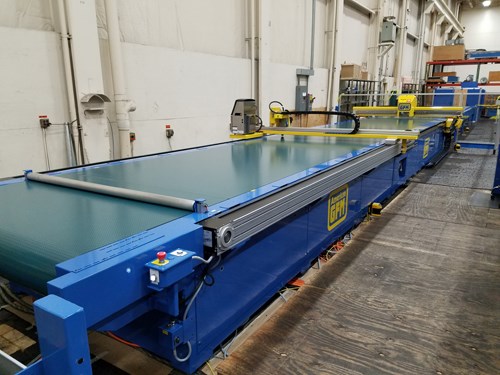
The AGFM/GFM system, Model US-120/CM-10, features a three-zone cutting table to segregate ply marking, ply cutting and ply offloading operations.
To address the non-productive time of the offloading operator(s), AGFM/GFM has developed the Model US-120/CM-10 automated ultrasonic ply cutting system. This system provides maximum possible throughput by enabling ply marking, ply cutting and ply offloading simultaneously, thereby enabling the operator to be consistently productive, offloading while the marking and cutting of additional plies are being performed simultaneously by separate gantries in separate zones along the length of the machine.
Plus, the cutting gantry is driven by a linear motor drive system; this provides ultrasonic ply cutting at a maximum of 4,800 inches/minute, as compared to 2,400 inches/minute on other AGFM ply cutters. Also, this model has a high positioning accuracy of ±0.004 inch. The production output of the US-120/CM-10, says AGFM/GFM, is more than twice that of the other ply cutters within, typically, no more floor space than other ply cutters.
Further, typically offloading of a ply cutter is performed by two operators, one on each side of the table, who simply pick plies off the table in no particular sequence, and place them onto the sorting table. Offloading in this manner, helps to clear the table more quickly by not having to be concerned about the sequence of the offloaded plies. This creates a complex task for the sorting operator, who then must sort and stack the plies in reverse sequence for lay up.
This combination of ply offloading in no particular sequence, and then sorting of plies and stacking in reverse layup sequence, often creates a stack not completely in reverse layup sequence and/or with lost or misplaced plies. Using laser projection as a layup aid helps to minimize the effects of out-of-sequence or missing plies, but does not eliminate production time lost for correction of such errors.
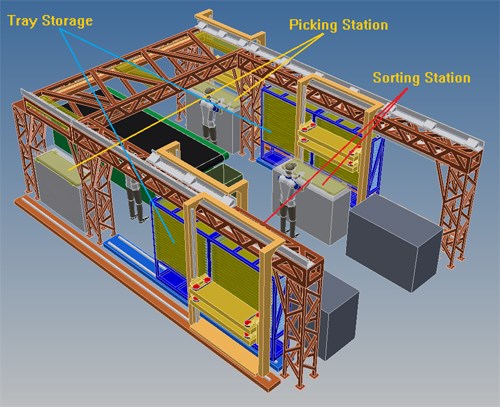
To further increase cutting and kitting efficiency, and to minimize ply sequencing errors,
AGFM/GFM's Pick & Distribute system uses laser guidance to direct operators regarding
which plies to pick and when. These are then sequenced in a sorting station into trays,
which store entire ply kits in reverse layup order.
To overcome this problem, AGFM/GFM have developed a new computer-supported system called Pick & Distribute (P&D). The system starts with an operator on each side of the machine offloading the plies from a given window (area on the ply cutter off-load table), guided by a laser pointing to the correct ply in reverse sequence of plies in that window, but with some gaps in the sequence. The gaps will be filled in at the next tray station, the final sorting station, which enables one operator to easily sort plies from trays that both offload operators have loaded onto trays. Therefore all plies in one kit are in correct reverse layup sequence. Also, the plies will be verified at each station, thus tracking each ply from offload to layup.
The individual kits can then be transported to either a freezer or directly to a layup station. All plies from a given kit will arrive at the layup station in reverse layup sequence. AGFM/GFM will exhibit at CAMX in September (Anaheim, California) and will feature a proof-of-concept video of this system in its booth (C57).
Related Content
Schmidt & Heinzmann camera system awarded 2022 AVK Innovation Award
“Pole Position” uses polarization properties to detect the positioning and orientation of carbon fibers during the cutting and stacking process, reducing waste and enhancing sustainability.
Read MorePlant tour: Airtech International, Springfield, Tenn., U.S.
Fifty years of supplying materials for composites manufacturing includes custom fabrication and now aims to advance 3D-printed tooling, parts and new resins.
Read MoreZCC Zünd Cut Center ushers in enhanced digital cutting automation
ZCC V.4 supports operators with several new smart, intuitive digital cutting functions throughout the composite material handling workflow.
Read MoreCompcut features ACS, PCR composite cutting technologies
Advanced plate saw and precision router provide precise, fast and efficient cutting of composite test specimens.
Read MoreRead Next
Composites end markets: Energy (2024)
Composites are used widely in oil/gas, wind and other renewable energy applications. Despite market challenges, growth potential and innovation for composites continue.
Read MoreCW’s 2024 Top Shops survey offers new approach to benchmarking
Respondents that complete the survey by April 30, 2024, have the chance to be recognized as an honoree.
Read MoreFrom the CW Archives: The tale of the thermoplastic cryotank
In 2006, guest columnist Bob Hartunian related the story of his efforts two decades prior, while at McDonnell Douglas, to develop a thermoplastic composite crytank for hydrogen storage. He learned a lot of lessons.
Read More











.jpg;maxWidth=300;quality=90)







